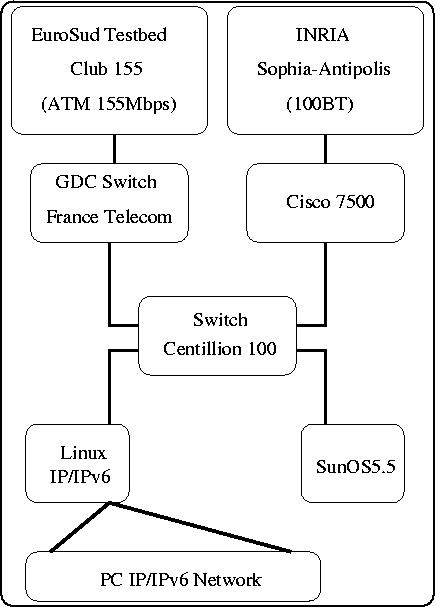IP over ATM in Sophia-Antipolis
IP over ATM in Sophia-Antipolis
Fall 1996 the Rodeo project configured an ATM test bed on which IP traffic
experiments were run. This yields a first performance evaluation of the
involved equipements.
The test bed

Two Sun Sparc 20 workstations, fitted with
Efficient Networks ATM cards, a CISCO's 4700 router, and a Bay Networks' router
are interconnected at 155 Mbps through a Bay Networks' Centillion 100 switch.
The physical connection is brought by multimode optical fibers using the SONET/SDH (Synchronous Optical NETwork/ Synchronous Digital Hierarchy) physical layer standard.
At the logical level, permanent virtual circuits (PVC) are established between the equipments.
Experiments
The tests consist in exchanging important floods of fixed sized IP packets
between the two workstations.
Two transport protocols are used, TCP and UDP.
Thus the performances of the two most used protocols over IP are examined
using the ttcp tool.
TCP serves to measure a secure flow, in connection mode, while UDP,
in datagram mode, gives
estimatioms of both bandwidth and link quality.
The type 5 (AAL5) adaptation layer is used.
This is so far (Early 97) the best supported layer; it gives a variable flow
rate connection oriented service.
For UDP the considered packet size range is (bytes):
8192, 1450, 1024, 512, 64.
The maximum size of 8192 bytes fits the biggest power of 2 inferior to
the IP/ATM link MTU size, namely 9180 bytes.
As for TCP, 8192 bytes packet are sent.
Between the two workstations we insert the switch, then
one router, then the other one in its place, and at last the two routers together.
The flow rate is measured in millions of bits per seconds (Mbps).
The results include:
The TCP throughput
The sent and received UDP throughput, in the form "sent\received",
and as a decreasing function of the packets size.
Exchanges local to the workstation
TCP: 200 Mbps -- The idle CPU time falls between 5 to 11%.
Exchanges through the switch
TCP: 80 Mbps
UDP: 105\100, 32\32, 25\25, 14\14, 2,5\2,5 Mbps
Exchanges through the Cisco router
TCP: 37 Mbps
UDP: 100\63, 27\24, 21\20, 12\9, 1,3\1,1 Mbps
Exchanges through the Bay Networks router
TCP: 50 Mbps
UDP: 95\62, 29\15, 25\24, 2,6\2,5 Mbps
Exchanges through the two routers
TCP: 29 Mbps
UDP: 117\58, 31\17, 25\16, 16\8, 2,6\1,1 Mbps
Conclusion
The TCP flow rate is very good. As for UDP, it is satisfactory only
long datagrams and very disappointing for short ones.
The routers appear unable to overshoot more than a third (about 40 Mbps)
of their 155 Mbps nominal throughput.
UDP throughput measurements show significant discordances among the datagram
sizes.
IP packet overhead explains only partially the performance breakdown
for little packet sizes.
Further experiments should investigate the respective influence of the
processing power of the hosts and of the performance of the ATM interface.
The TCP performance is satisfactory if not optimal up to the nominal 155 Mbps
theoretical throughput. This may result from a bad adaptation to high speeds
of the TCP windowing mechanism.
The testbed is heterogeneous and its tuning is a bit tricky.
Some further research is on to optimize
the configuration and insure full efficient interoperability.

